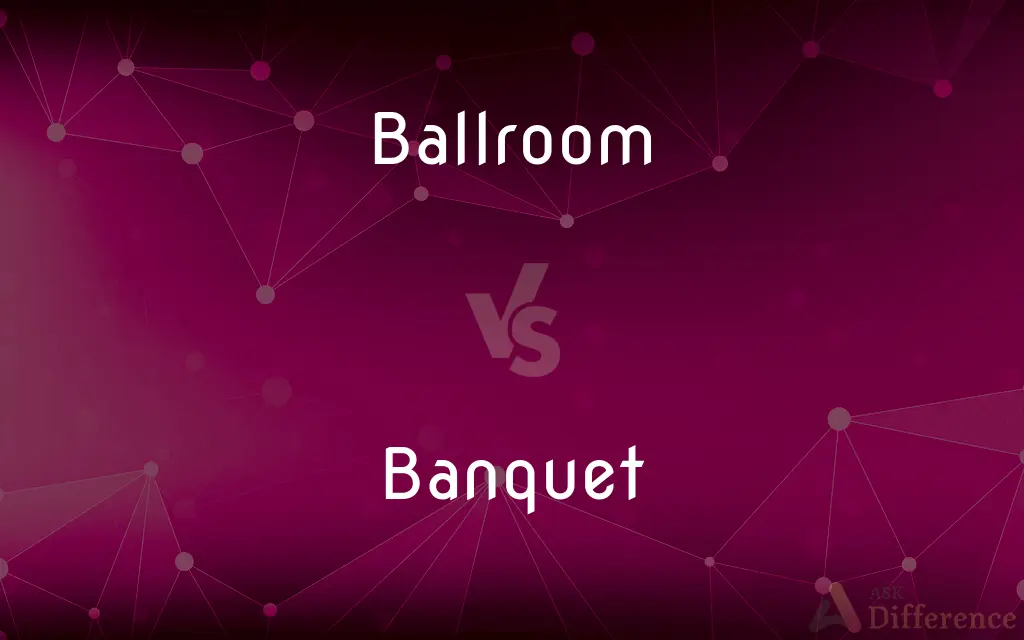Ballroom vs. Banquet — What's the Difference?
Edited by Tayyaba Rehman — By Maham Liaqat — Updated on February 27, 2024
A ballroom is a large, formal room designed for dancing events, while a banquet hall is a spacious room intended for hosting meals for large gatherings. Each serves distinct social functions, with ballrooms focusing on dance and banquets on dining.

Difference Between Ballroom and Banquet
Table of Contents
ADVERTISEMENT
Key Differences
Ballrooms and banquet halls serve as venues for large gatherings, but their primary purposes differ significantly. Ballrooms, characterized by their large, open floors, are specifically designed to accommodate dancing. They often feature elaborate decor and are used for formal dances, balls, and dance-related events. In contrast, banquet halls are equipped to host large dining events, such as wedding receptions, award ceremonies, and corporate dinners. These spaces are arranged with tables and seating to facilitate meal service and speeches, rather than dancing.
The design and layout of ballrooms emphasize ease of movement and acoustics suitable for music and dancing, often including a raised platform or stage for musicians or DJs. Banquet halls, however, prioritize seating arrangements and catering facilities, including buffet setups or spaces for plated meal service, as well as podiums for speakers.
Ballrooms are traditionally associated with elegance and grandeur, reflecting their historical roots in social dance culture. They may be part of hotels, estates, or standalone entities, often used for formal events like galas. Banquet halls can also be elegant but are more versatile, catering to a wide range of events from formal to semi-formal, including not only meals but also conferences and seminars where dining is a component.
Ballrooms may sometimes be adapted for banquet-style events by adding tables and chairs, though this is not their primary design. Conversely, banquet halls might accommodate dance floors and music, but their layout is primarily configured for dining and seated events.
Safety and accessibility considerations also differ, as ballrooms must ensure a clear and unobstructed dance floor, while banquet halls focus on accommodating dining setups and food service logistics, including kitchen access and service pathways.
ADVERTISEMENT
Comparison Chart
Primary Purpose
Dancing events
Dining events
Design Focus
Open floor for dancing, acoustics for music
Seating arrangements, catering facilities
Traditional Use
Formal dances and balls
Wedding receptions, corporate dinners
Layout Adaptability
Can be adapted for dining
Can include dance floors, more focused on dining
Decor and Ambiance
Elegant, often with historical elements
Versatile, ranges from formal to semi-formal
Compare with Definitions
Ballroom
Space with a focus on dancing and music.
The new ballroom features a state-of-the-art sound system.
Banquet
Sometimes adapted for presentations or conferences.
The banquet hall was arranged for the medical conference.
Ballroom
Venue for formal gatherings with dancing.
Their wedding reception was held in a grand ballroom.
Banquet
Space equipped for meal service and speeches.
The banquet hall's layout included a podium for awards.
Ballroom
A large room designed for dance events.
The hotel's ballroom was decorated for the annual charity ball.
Banquet
Designed with catering and seating in mind.
The banquet hall's kitchen can serve up to 500 guests.
Ballroom
Historically, a social dancing venue.
The estate's ballroom has hosted dances since the 19th century.
Banquet
A room for large dining events.
The banquet hall was prepared for the company's annual dinner.
Ballroom
Adaptable for various dance types.
The ballroom was set up for a salsa competition.
Banquet
Venue for weddings, ceremonies, and dinners.
They booked a banquet hall overlooking the city.
Ballroom
A ballroom or ballhall is a large room inside a building, the primary purpose of which is holding large formal parties called balls. Traditionally, most balls were held in private residences; many mansions contain one or more ballrooms.
Banquet
A banquet (; French: [bɑ̃kɛ]) is a formal large meal or feast, where a number of people consume food together. Banquets are traditionally held to enhance the prestige of a host, or reinforce social bonds among joint contributors.
Ballroom
A large room for dancing.
Banquet
An elaborate and formal evening meal for many people
A state banquet at Buckingham Palace
Ballroom
A large room used for dancing and banquets.
Banquet
An elaborate, sumptuous meal; a feast.
Ballroom
A type of elegant dance.
Banquet
A ceremonial dinner honoring a particular guest or occasion.
Ballroom
(intransitive) To take part in ballroom dancing.
Banquet
A large celebratory meal; a feast.
Ballroom
A room for balls or dancing.
Banquet
A ceremonial dinner party for many people.
Ballroom
Large room used mainly for dancing
Banquet
A ceremonial dinner party for many people
Common Curiosities
Are banquet halls only for dining events?
Primarily, yes, but they can also accommodate other functions, including presentations and conferences, with or without dance areas.
How do ballrooms and banquet halls differ in design?
Ballrooms prioritize open dance floors and acoustics, while banquet halls focus on dining setups and catering facilities.
What is a ballroom?
A ballroom is a large room designed primarily for dancing and music events.
What is a banquet hall?
A banquet hall is a spacious room intended for hosting large meal-focused gatherings.
What types of events are suitable for banquet halls?
Banquet halls are suitable for wedding receptions, corporate dinners, award ceremonies, and similar dining events.
Can a ballroom be used for a banquet?
Yes, ballrooms can be adapted for banquets by arranging tables and chairs, though this is not their primary purpose.
Do ballrooms have specific architectural features?
Many ballrooms feature elaborate decor, high ceilings, and sometimes historical elements conducive to dancing and music.
What facilities are important for a banquet hall?
Important facilities include a well-equipped kitchen, versatile seating arrangements, and spaces for food service and speeches.
What are the key considerations for banquet hall setup?
Key considerations include efficient meal service logistics, comfortable seating arrangements, and accommodating a large number of guests.
How do event planners choose between a ballroom and a banquet hall?
The choice depends on the event's primary activity—dancing favors a ballroom, while dining or seated events are better suited to a banquet hall.
What kind of events are held in ballrooms?
Events such as formal dances, balls, and dance competitions are typically held in ballrooms.
How does the ambiance differ between ballrooms and banquet halls?
Ballrooms often exude elegance and grandeur, while banquet halls offer a more versatile ambiance that can range from formal to semi-formal.
Can the same venue offer both a ballroom and a banquet hall?
Yes, many venues, especially hotels and conference centers, offer both ballrooms and banquet halls to cater to different event needs.
Is historic significance more associated with ballrooms or banquet halls?
Historic significance is more commonly associated with ballrooms due to their long-standing cultural role in social dance events.
What safety considerations apply to ballrooms?
Safety in ballrooms focuses on maintaining a clear dance floor and ensuring good acoustics and lighting.
Share Your Discovery

Previous Comparison
Eye vs. Eyes
Next Comparison
Gavel vs. GrainAuthor Spotlight
Written by
Maham LiaqatEdited by
Tayyaba RehmanTayyaba Rehman is a distinguished writer, currently serving as a primary contributor to askdifference.com. As a researcher in semantics and etymology, Tayyaba's passion for the complexity of languages and their distinctions has found a perfect home on the platform. Tayyaba delves into the intricacies of language, distinguishing between commonly confused words and phrases, thereby providing clarity for readers worldwide.














































